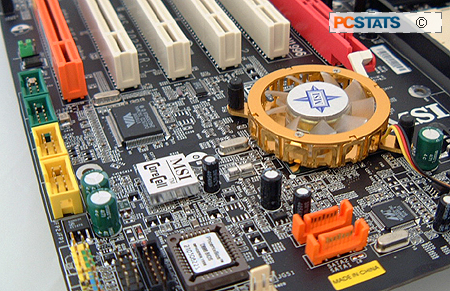You might
be asking yourself, what is this "Ultra" thing tagged onto the nForce3 chipset?
Well, nVidia's new NF3 Ultra is basically the NF3-250 chipset with some socket 939 support tossed in, and fixes
for all the bugs steaming from the original NF3-150 chipset. The nForce3 Ultra is a single chip solution
like its predecessors, but where IDE was the norm, it now natively supports four
Serial ATA channels and SATA
RAID.

'NVidia
RAID' is a glossed up version of the IDE RAID we have been seeing on
motherboards for many months now, and it offers the standard package of RAID 0, 1,
0+1 and JBOD arrays. Users can mix and match IDE and Serial ATA drives, but other than that its
a pretty standard feature which nVidia ought to have implemented long ago.
While I
doubt the vast majority of end users can fully take advantage of Gigabit
ethernet, it seemed a little cheap that the NF3-150 only included a
10/100 MAC in its time. The nForce 3 Ultra resolves this gripe, and features
Gigabit networking run through its own dedicated bus, not through the PCI bus.
This approach is similar to that of Intel's CSA
Gigabit Ethernet solution.
Rounding out the list of features the NF3 Ultra offers us is a novel hardware firewall
for that network connection, called appropriately enough the nVidia Radeon Firewall. The nVidia
Firewall is a hardware based solution, and it is included on
the NF3-250GB chipset as well... and yes I'm just pulling your leg about the
'Radeon' bit. ;-)
nVidia has also increased the number of USB
2.0 ports to eight on the NF3 Ultra chipset. Apparently it even optimized the
NF3 Ultra chipset to run better with nVidia-based videocards. As PCstats has shown in
the past look at the MSI K8N Neo Platinum motherboard review, this is true. If you own an ATI video card,
the MSI K8N Neo2 Platinum will work just fine with it; nVidia did
not engineer any hadicaps into the NF3
Ultra to affect performance with non-nVidia graphics solutions.
